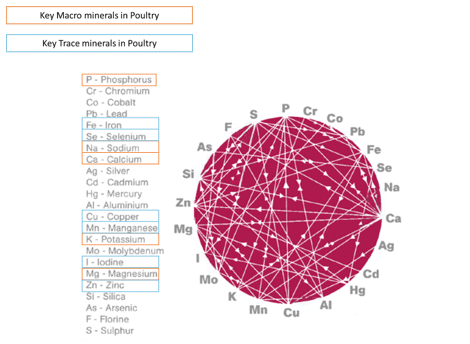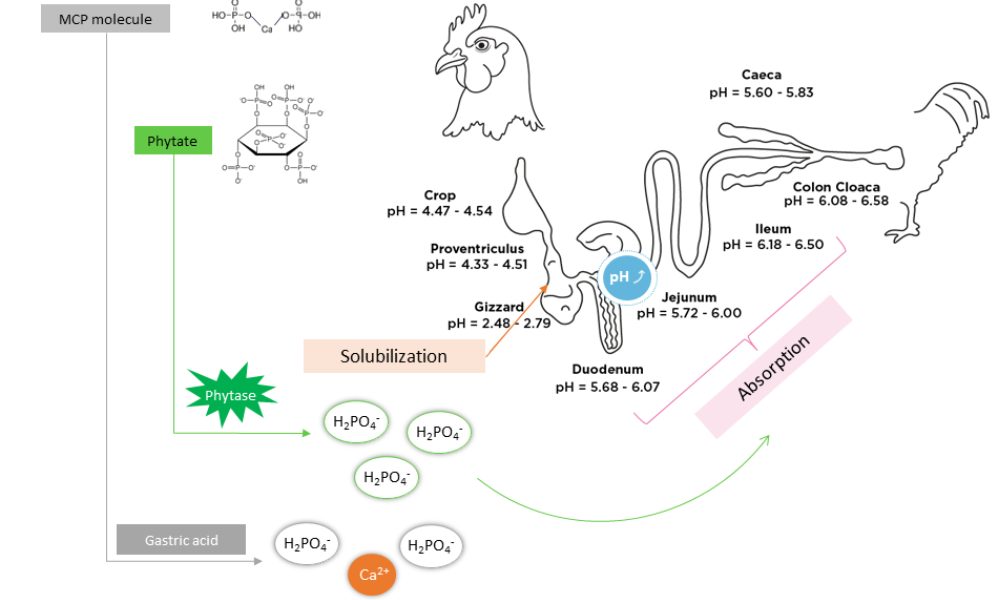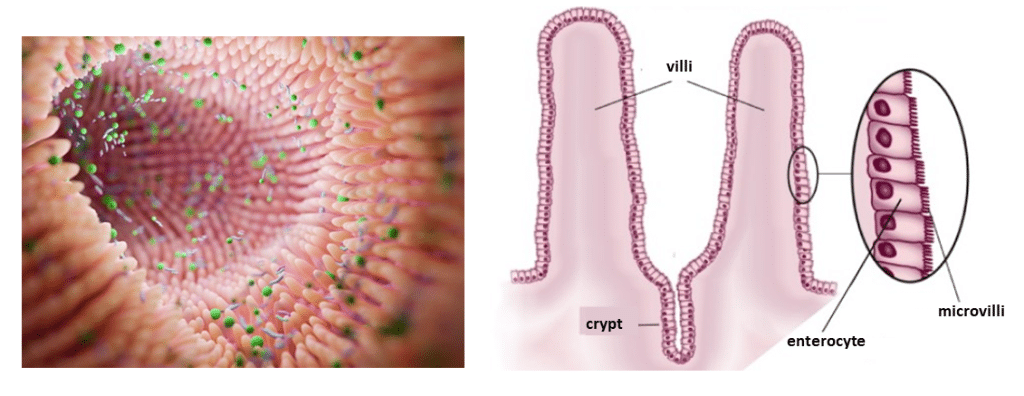Phosphorus and calcium, two essential macro-minerals in poultry

Figure 1. Mulder’s Chart (or Wheel) – Complex minerals interaction
Did you know ?
- The presence in the diet of an adequate supply of each element in available form (mineral, vegetal or animal source)
- A suitable ratio of available Ca and P in the diet, although today we still tend to measure Ca on a total basis
- The level of vitamin D3 in the diet
- Whether or not an exogenous phytase enzyme has been included in the diet, as the inclusion of this enzyme impacts Ca and P absorption rate.
Phosphorus is brought to the diet by 85% from plant and 15% from inorganic feed phosphate and/or animal source. On one hand, plant-based phosphorus availability is highly dependent of the subtract. As mentioned in Rostagno 2017 study, not all plant materials are equal in term of phosphorus content and percentage of phytic acid (cf. Table 1). For example, corn and rye may bring approximately the same amount of P phytic (2.1 g/kg) but do not have the same total P content (2.9 g/kg vs 3.5 g/kg). Moreover, phosphorus can also fluctuate from one source to another and from the quality of the land it was cultivated in. To resume, plant-based phosphorus is influenced by 3 main factors :
- The subtract specification
- The phytic P content in the subtract
- The quality of the phytase (used to release the P in the gut, originally under phytic form)
| Plant food | P (g/kg) | Phytic Total P (%) | Phytic P (g/kg) | Coefficient of variation |
|---|---|---|---|---|
| Corn | 2,9 | 75 | 2,17 | 12 % |
| Barley | 3,9 | 54 | 2,11 | N |
| Rye | 3,5 | 62 | 2,17 | NA |
| Tritical | 3,8 | 76 | 2,89 | NA |
| Rapeseed meal | 7,2 | 70 | 5,04 | 9 % |
| Sobybean meal | 7,1 | 59 | 4,19 | 15 % |
| Sunflower mea | 11,5 | 85 | 9,78 | 16 % |
Table 1. Phytic phosphorus from plant feed materials
Source : www.feedtables.com
| MCP | DCP | |
|---|---|---|
| Total phosphorus (%) | 22,7 | 18 |
| Digestible P (%) | 19,30 | 14,04 |
| Coefficient digestibility in poultry (CVB tables, 2019) | 85 | 78 |
Table 2. Phosphorus digestibility from inorganic feed phosphates in poultry
How do minerals interact in the intestine ?
Mineral utilization by animals mainly depends on their absorption from the ingested feed in which minerals are found in a wide range of chemical form. The availability of minerals in typical feed ingredients varies and is primarily due to the formation or presence of poorly soluble complexes in both plant material and the GIT of birds.
Mineral absorption requires solubilisation of mineral original source in the intestinal lumen. This process is pH-dependent, therefore the acidic environment in proventriculus and gizzard improves their solubilisation. By contrast, neutral or alkaline pH of the intestine reduces their solubilisation. Solubilisation is the natural process for mineral source of phosphorus. On the other hand, vegetal source requires the action of specific enzyme, phytase, to release the P into the gut. Today, phytase incorporation tend to increase to 1000FTU/kg – 2000 FTU/kg, in order to release more P phytic from the diet (cf. Figure 2). But Kleyn and Chrystal, 2020, recommend caution to be taken in ascribing too high a value for the P contribution of phytase because problems may arise if there is inadequate substrate in the diet.
Mineral absorption depends on the capacity of minerals to bind to transport protein present in enterocyte membrane (cf. Figure 3). But their absorption can be disturbed by the formation of insoluble complexes. This is the case for phosphorus which can encounter the anti-nutritional effect of calcium. And today this is the main problematic of phytase efficacy. The formation of phytate-Ca complexes limits the action of the phytase in the gut, making not accessible the P phytic hydrolysis by the phytase and consequently reducing the amount of P released and absorbed through the intestine.
Today, nutritional strategies are being tested to reduce the Ca anti-nutritional effect, such as :
- The reduction of Ca incorporation in the diet. Studies have been demonstrating similar animal performances, but caution must be taken regarding the Ca requirements for bones.
- A balanced incorporation of fine and coarse limestone. Indeed, the speed of the limestone solubilisation will dictate the concentration of Ca available to chelate with the phytate.
- The diet formulation with digestible Ca instead of total Ca. Actually, scientific studies are being processed and should propose some new concepts of formulation in the following years.
- The utilization of specific mineral solutions that can limit Ca-phytate complexes. One of the new generation organic-mineral complex developed and patented by Phosphea, called Calcium humophosphate and branded under Hum IPHORA, helps to control Ca release in the gut, and thus decrease Ca anti-nutritional effect and contribute to improve plant-based phosphorus utilization.

Figure 2: Phosphorus absorption in poultry digestive tract
